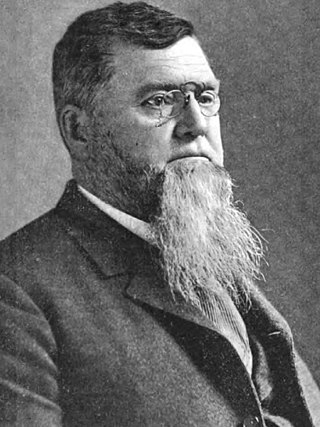
The 1896 Democratic National Convention, held at the Chicago Coliseum from July 7 to July 11, was the scene of William Jennings Bryan's nomination as the Democratic presidential candidate for the 1896 U.S. presidential election.

Lorrin Alanson Cooke was an American politician and the 57th governor of Connecticut from 1897 to 1899.

The 1898 New York state election was held on November 8, 1898, to elect the governor, the lieutenant governor, the Secretary of State, the state comptroller, the attorney general, the state treasurer and the state engineer, as well as all members of the New York State Assembly and the New York State Senate. This election is the most recent election to feature a candidate for governor of New York who eventually became both Vice President of the United States and President of the United States after serving as Governor of New York.

The 1896–97 United States Senate elections were held on various dates in various states. As these U.S. Senate elections were prior to the ratification of the Seventeenth Amendment in 1913, senators were chosen by state legislatures. Senators were elected over a wide range of time throughout 1896 and 1897, and a seat may have been filled months late or remained vacant due to legislative deadlock. In these elections, terms were up for the senators in Class 3.

The 1974 Massachusetts gubernatorial election was held on November 5, 1974. Michael Dukakis was elected to a four-year term, from January 2, 1975 until January 4, 1979. He defeated incumbent Governor of Massachusetts Francis W. Sargent in the general election.
The 1974 Massachusetts general election was held on November 5, 1974, throughout Massachusetts. Democratic and Republican candidates were selected in party primaries held September 10, 1974.
The 1966 Massachusetts general election was held on November 8, 1966, throughout Massachusetts. Primary elections took place on September 13.

The 1940 United States Senate election in Pennsylvania was held on November 5, 1940. Incumbent Democratic U.S. Senator Joseph F. Guffey successfully sought re-election to another term, defeating the Republican nominee, Jay Cooke.

The 1972 United States presidential election in South Carolina took place on November 7, 1972. All 50 states and the District of Columbia were part of the 1972 United States presidential election. South Carolina voters chose 8 electors to the Electoral College, who voted for president and vice president.

The 1972 United States presidential election in Indiana took place on November 7, 1972. All fifty states and the District of Columbia were part of the 1972 United States presidential election. State voters chose 13 electors to the Electoral College, who voted for president and vice president.

The 1964 Illinois gubernatorial election was held in Illinois on November 3, 1964. The Democratic nominee, incumbent Governor Otto Kerner, Jr., won reelection against the Republican nominee, Charles H. Percy.

The 1970 Maryland gubernatorial election was held on November 3, 1970. Incumbent Democrat Marvin Mandel defeated Republican nominee Charles Stanley Blair with 65.73% of the vote. This election was the first of eight consecutive Democratic gubernatorial victories in Maryland, a streak not broken until the election of Republican Bob Ehrlich in 2002.

The 1934 New Hampshire gubernatorial election was held on November 6, 1934. Republican nominee Styles Bridges defeated Democratic nominee John L. Sullivan with 50.55% of the vote.

The 1928 New Hampshire gubernatorial election was held on November 6, 1928. Republican nominee Charles W. Tobey defeated Democratic nominee Eaton D. Sargent with 57.50% of the vote.

The 1896 North Carolina gubernatorial election was held on November 3, 1896. Republican nominee Daniel Lindsay Russell defeated Democratic nominee Cyrus B. Watson with 46.52% of the vote. This was the only election in North Carolina between 1872 and 1972 in which the Republican nominee won the governor's office, and the only one until 2016 in which no candidate received over 50% of the vote.

The 1956 Illinois gubernatorial election was held in Illinois on November 6, 1956. Incumbent Governor William Stratton, a Republican, narrowly won reelection to a second term. Stratton's narrow victory came despite the fact that the Republican ticket of Dwight D. Eisenhower and Richard Nixon carried the state of Illinois in a landslide in the presidential election.

The 1960 Illinois gubernatorial election was held in Illinois on November 8, 1960.

The 1896 Montana gubernatorial election was held on November 3, 1896.

The 1896 Arkansas gubernatorial election was held on September 7, 1896.





















